Prevalence, Characteristics, and Poverty Status of Supplemental Security Income Multirecipients
Social Security Bulletin, Vol. 73, No. 3, 2013 (released August 2013)
“Multirecipients” are people who receive Supplemental Security Income (SSI) payments while living with other recipients (not including an SSI-eligible spouse). Using Social Security Administration records matched to Current Population Survey data for 2005, this article examines multirecipients' personal, family, household, and economic characteristics. I find that no more than 20 percent of the 2005 SSI population were multirecipients. Most multirecipients were adults, lived with one other recipient, and/or shared their homes with related recipients. Multirecipients were generally less likely to be poor than SSI recipients as a whole; but those who were children, lived with one other recipient, and/or shared their homes with a nonrecipient were more likely to be poor. Implementing sliding-scale SSI benefit reductions for children in multirecipient households would affect about 23 percent of multirecipients, or about 5 percent of all SSI recipients.
Joyce Nicholas is a social science research analyst in the Office of Program Development and Research, Office of Retirement and Disability Policy, Social Security Administration.
Contents of this publication are not copyrighted; any items may be reprinted, but citation of the Social Security Bulletin as the source is requested. The findings and conclusions presented in the Bulletin are those of the authors and do not necessarily represent the views of the Social Security Administration.
Introduction
| CPS | Current Population Survey |
| FBR | federal benefit rate |
| NCM | noncouple multirecipient |
| SSA | Social Security Administration |
| SSI | Supplemental Security Income |
Since 1974, the Supplemental Security Income (SSI) program has provided income of last resort to the aged, blind, and disabled, and in December 2011, the program served 8.1 million recipients (SSA 2012a). This article examines the characteristics of SSI recipients who lived with at least one other recipient who was not an eligible spouse, in both the narrower family context and the broader household context.1 The analysis starts by focusing on SSI families because the Census Bureau uses the family unit to generate official poverty estimates. In the family-level analysis, recipients who lived with at least one other related recipient are called “noncouple multirecipients” (NCMs). I then analyze the household unit to consider the full scope of recipients who reside with other recipients and the economies of scale they benefit from within their larger households. SSI recipients who shared their larger households with related or unrelated recipients are simply called “multirecipients.”
The analysis is based on matched Social Security Administration (SSA) and Current Population Survey (CPS) data for calendar year 2005.2 With those data, I examine the personal, family, household, demographic, and economic circumstances of recipients living with other recipients and compare them with those of all other recipients. This article addresses four research questions:
- How prevalent were NCMs in the SSI population and what proportion of them were children?
- What was the family composition of NCMs?
- How did the poverty status of NCMs compare with that of other SSI subgroups?
- What proportion of the SSI population belonged to multirecipient households and what were their characteristics?
The article concludes with a summary of key research findings and their implications.
Program Overview
In 1972, Congress passed legislation creating the SSI program to ensure a minimum income for the aged, blind, and disabled to help them meet their basic food, clothing, and shelter needs. A person must meet three criteria to qualify for SSI payments. He or she must (1) be at least 65 years of age, disabled, or blind; (2) have countable resources at or below a legislated threshold; and (3) have countable income (including deemed income)3 that is lower than the SSI federal benefit rate (FBR).
Federal Benefit Rate
Adjusted annually according to cost-of-living increases, the FBR is the maximum possible federal SSI payment amount. SSA uses one FBR to compute payments for individuals and another FBR for couples. In both cases, SSA considers the recipient's total countable earned and unearned income to determine the final payment amount.4 If a recipient lives with a spouse who also qualifies for SSI payments, their payment amount is based on the FBR for a couple, which equals 150 percent of the individual FBR.5 In effect, each eligible spouse's share of SSI benefits is 75 percent of the individual FBR.6 For 2005, I estimate that 5.9 percent of SSI recipients received payments based on the couple FBR while the remaining 94.1 percent received payments based on the individual FBR.
By law, SSI payment rates for individuals and couples differ because their economies of scale are assumed to differ. Specifically, the couple FBR is based on the premise that two eligible spouses residing within one household require less income to meet their needs than two individuals who live independently (Koenig and Rupp 2003/2004). By contrast, no economies of scale are assumed to arise among nonmarried SSI recipients sharing a household. Thus, two eligible spouses living together receive a payment based on the couple FBR (equal to 150 percent of the individual FBR), while the payment for two nonmarried recipients residing together is based on an amount equal to 200 percent of the individual FBR. The reason the lower FBR does not apply to noncouple recipients living together is that they may not share household expenses if they are unrelated, or the sharing may vary substantially over time, especially in transient households.
SSI Family Residency Groups
For the family-level analysis of the SSI population, I define “individuals” as those who receive payments based on the individual FBR as the sole SSI recipient in their families. Those classified as “NCMs” live in families that include two or more SSI recipients, all of whom receive payments based on the individual FBR (that is, none are an eligible spouse). Examples of NCMs include, but are not limited to, a child recipient living with a brother and a sister who also draw SSI payments; a single-mother recipient whose daughter also receives SSI; and a single man on SSI who resides with his grandmother, who is also on the SSI rolls. The group classified as “couples” comprises SSI recipients who receive payments based on the couple FBR. In sum, we divide SSI recipients into three family residency groups: individuals, NCMs, and couples. Recipients belonging to any one of these groups may also live with nonrecipients, who are presumably ineligible for SSI. The following tabulation shows the 2005 populations for each group, along with the child-adult breakdown.
| SSI recipient characteristic | Population |
|---|---|
| Total | 7,369,357 |
| Family residency group | |
| Individual | 5,781,022 |
| Couple | a 432,635 |
| NCM | 1,155,700 |
| Age | |
| Child (aged 17 or younger) | 997,049 |
| Adult (aged 18 or older) | 6,372,308 |
| SOURCE: Author's calculations based on CPS data matched to SSI administrative records. | |
| a. The count reflects person-level recipients and not the number of pairs that receive payments based on the couple FBR. | |
Findings
This section addresses each of the four research questions in turn.
Research Question 1
How Prevalent Were NCMs and What Proportion Were Children? In 2005, 15.7 percent of SSI recipients were NCMs (Chart 1). Adult NCMs (aged 18 or older) represented 11.3 percent of SSI recipients and child NCMs (aged 17 or younger) represented 4.4 percent of SSI recipients. Although adult NCMs were a larger percentage of the overall SSI population, child recipients were more than twice as likely as adult recipients to be NCMs (32.5 percent versus 13.0 percent).
Percentage distribution of SSI recipients by family residency group and age, 2005
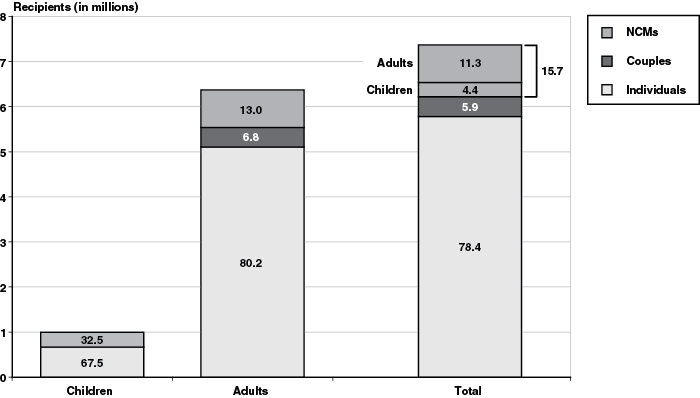
Charts 2 and 3 illustrate the age distributions of NCMs and of individuals and couples, respectively. Children constituted 28.0 percent of NCMs and only 10.8 percent of individuals and couples. The average age of NCMs was 38, 10 years younger than the average for individuals and couples (not shown).
Percentage distribution of NCMs by age, 2005
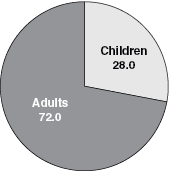
Percentage distribution of (combined) individual and couple recipients by age, 2005
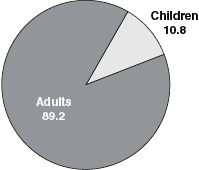
Research Question 2
What Was the Family Composition of NCMs? In this analysis, “family composition” reflects several overlapping characteristics: the number of SSI recipients in the family (two, three, or four or more); whether the family includes any nonrecipients; and whether the family's recipients comprise only children, only adults, or both. The tabulation below shows the population estimates for each NCM characteristic.
| NCM characteristic | Population |
|---|---|
| Total | 1,155,700 |
| Age | |
| Child | 324,108 |
| Adult | 831,592 |
| Recipients in family | |
| Two | 883,624 |
| Three | 200,139 |
| Four or more | 71,937 |
| Nonrecipients in family | |
| None | 367,172 |
| One or more | 788,528 |
| Recipients in the family are— | |
| All children | 147,388 |
| All adults | 632,685 |
| Children and adults | 375,627 |
| SOURCE: Author's calculations based on CPS data matched to SSI administrative records. | |
Chart 4 illustrates the distribution of NCMs by the number of SSI recipients and the presence (or absence) of nonrecipients in their families. More than three-quarters (76.5 percent) of NCMs resided in families with two recipients. Only 6.2 percent belonged to families with four or more recipients; that group constituted less than 1 percent of the entire 2005 SSI population. The remaining 17.3 percent of NCMs had three recipients in their families. The shares of NCMs who lived exclusively with other recipients sum to 31.7 percent. The largest single group, making up more than one-half of NCMs (53.8 percent), consisted of those in families with only two recipients and at least one nonrecipient.
Percentage distribution of NCMs by number of family recipients and presence of nonrecipients, 2005
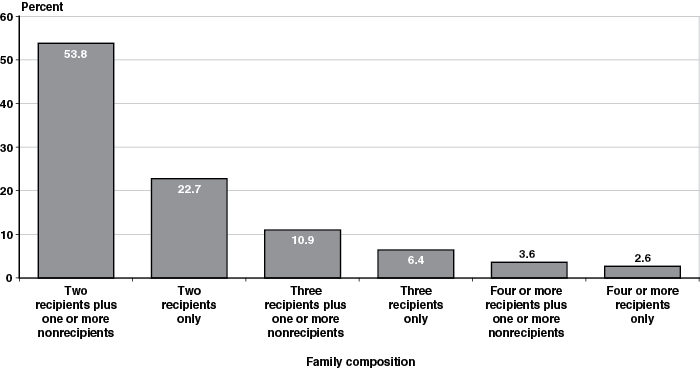
Chart 5 shows the distribution of NCMs by number of recipients in the family and age. It illustrates that children were more likely to belong to families with four or more recipients than adults were (8.5 percent versus 5.3 percent). Nearly the same proportions of child and adult NCMs belonged to families with two recipients (about 76 percent).
Percentage distribution of NCMs by number of family recipients and age, 2005
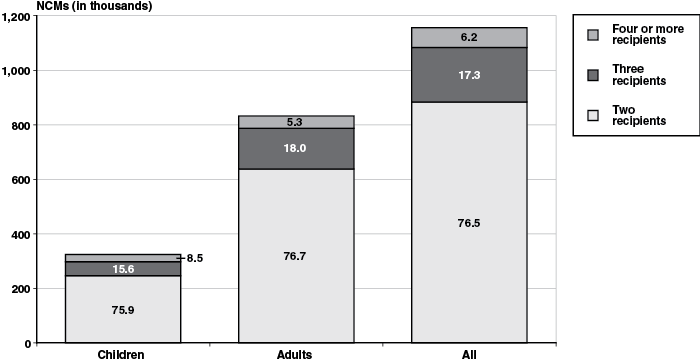
Chart 6 combines the family composition characteristics. It shows the distributions of NCMs among all-child, all-adult, and mixed-age family recipient status, with breakdowns by NCM age group, family recipient count, and presence of nonrecipients in the family. Overall, NCMs were most likely to belong to families with recipients who were all adults and were least likely to live with recipients who were all children (54.7 percent versus 12.8 percent). The remaining 32.5 percent of NCMs had both child and adult recipient family members.
Family composition characteristics for NCMs, 2005 (percentage distributions)
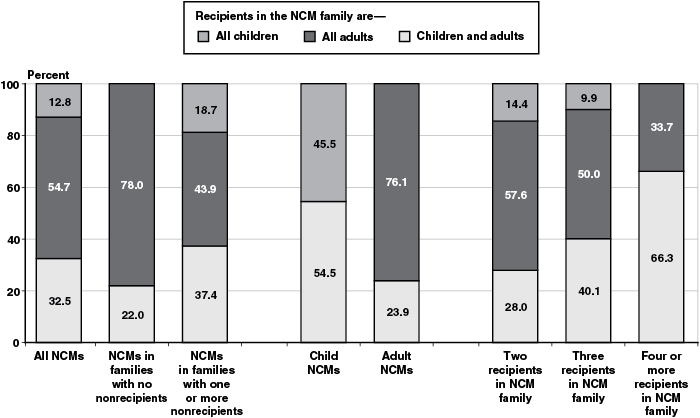
Chart 6 reveals three additional key findings. First, NCMs belonging to recipient-only families were most likely to be adults: 78.0 percent of NCMs belonging to recipient-only families had only adult recipients in their families, while only 43.9 percent of NCMs with at least one nonrecipient lived in a family in which all recipients were adults. Second, child NCMs were less likely to live with other recipients who were all children (45.5 percent) than adult NCMs were to live with other recipients who were all adults (76.1 percent). Third, as family recipient counts increased, NCMs were less likely to reside with recipients who were all adults. Instead, they were more likely to belong to families with both child and adult recipients.
Research Question 3
How Did the Poverty Status of NCMs Compare With That of Other SSI Subgroups? I used matched SSA and CPS data along with the Census Bureau's official poverty measure to evaluate the economic well-being of SSI recipients.7 In considering the findings, one should be mindful of certain SSI program effects on recipient poverty status. If individuals or couples have SSI as their only source of income while belonging to a recipient-only family, they will be poor because the SSI annualized FBR for individuals and couples is less than the annual poverty thresholds applicable to one- and two-person families, respectively.8 By contrast, if NCMs live with other recipients only, they will not be classified as poor. That is because the SSI program assumes no economies of scale among nonmarried individuals living together and the FBR is the same for each additional family recipient, but the Census Bureau assumes greater economies of scale with each additional family member and reduces the incremental increase in family poverty thresholds accordingly. Therefore, all of the individual federal benefits paid to NCMs belonging to a recipient-only family will exceed the poverty threshold applicable to their family.
Baseline SSI Poverty Rates. In 2005, an estimated 41.9 percent of SSI recipients lived in poverty (Chart 7).9 NCMs had a poverty rate of 19.8 percent, while more than 45 percent of individual and couple recipients were poor. Child recipients had a poverty rate of about 29 percent whether they were individual recipients or NCMs.10 Among NCMs, child recipients were almost twice as likely as adults to be poor (29.5 percent versus 15.9 percent).
Poverty rates for SSI recipients by family residency group and age, 2005 (in percent)
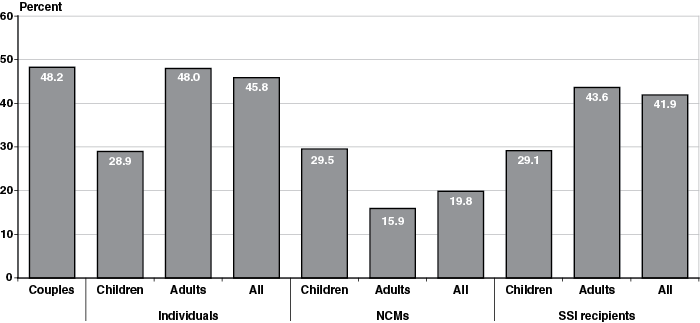
SSI's effects on recipients' poverty status vary by family residency group and presence of nonrecipients. About 25 percent of SSI recipients who lived with at least one nonrecipient were poor, regardless of whether they were individuals/couples or NCMs (Chart 8). Recall that among those in recipient-only families where SSI is the only family income, NCMs will not be poor, while individuals and couples will be. Individuals and couples who belonged to recipient-only families were among the most likely to be poor, with a poverty rate of 71.9 percent. NCMs in recipient-only families had the lowest poverty rate, 8.4 percent.11 However, 39.4 percent of NCMs in recipient-only families were living in near-poverty.
Percentage distribution of SSI recipients by poverty status, family residency group, and presence of nonrecipients in family, 2005
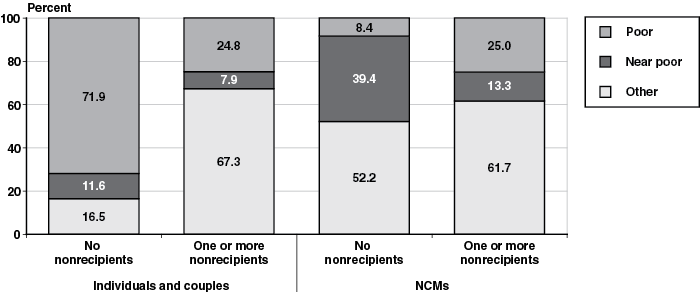
NCM Poverty Rates. Child recipients living in two-recipient families had the highest NCM poverty rate (37.2 percent) among all age and number-of-recipient categories (Table 1). The poverty rate among all NCMs in two-recipient families, 24.4 percent, nearly quadrupled the rate for three-recipient families (6.4 percent). By contrast, no NCMs in families with four or more recipients were poor. As stated earlier, children were nearly twice as likely to be poor as their adult counterparts (29.5 percent versus 15.9 percent). Therefore, the number of SSI recipients in the family appears to be a stronger determinant of NCM poverty than age.
| Recipients in family | Children | Adults | All |
|---|---|---|---|
| Population | |||
| Two | 246,131 | 637,493 | 883,624 |
| Three | 50,457 | 149,682 | 200,139 |
| Four or more | 27,520 | 44,417 | 71,937 |
| Total | 324,108 | 831,592 | 1,155,700 |
| Poverty rate (percent) | |||
| Two | 37.2 | 19.5 | 24.4 |
| Three | 8.5 | 5.7 | 6.4 |
| Four or more | 0.0 | 0.0 | 0.0 |
| Total | 29.5 | 15.9 | 19.8 |
| SOURCE: Author's calculations based on CPS data matched to SSI administrative records. | |||
Chart 9 shows that the poverty rate for NCMs in families in which all recipients were adults was 11.5 percent, and for those in families in which all recipients were children, it was 26.9 percent. NCMs who were members of families with both child and adult recipients had the highest poverty rate of the three categories, at 30.9 percent.
Poverty rates for NCMs by age of recipients in family, 2005 (in percent)
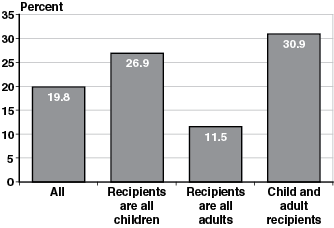
Table 2 shows that NCMs residing in families with both child and adult recipients consistently had the highest poverty rates regardless of other family characteristics. Table 2 also reaffirms previously noted findings that NCMs were more likely to be poor if they had fewer recipients in the family, were children, or lived with at least one nonrecipient.
| Characteristic | Recipients in the NCM family are— | All | ||
|---|---|---|---|---|
| All children | All adults | Children and adults | ||
| Recipients in family | ||||
| Two | 31.1 | 13.3 | 43.7 | 24.4 |
| Three | 0.0 | 4.7 | 10.0 | 6.4 |
| Four or more | 0.0 | a | 0.0 | 0.0 |
| NCM age | ||||
| Child | 26.9 | . . . | 31.7 | 29.5 |
| Adult | . . . | 11.5 | 30.2 | 15.9 |
| Nonrecipients in family | ||||
| None | a | 7.7 | 10.9 | 8.4 |
| One or more | 26.9 | 14.6 | 36.4 | 25.0 |
| SOURCE: Author's calculations based on CPS data matched to SSI administrative records. | ||||
| NOTE: . . . = not applicable. | ||||
| a. Insufficient sample size. | ||||
Research Question 4
How Many SSI Recipients Belonged to Multirecipient Households and What Were Their Characteristics? Many people have proposed sliding-scale benefit reductions for children belonging to SSI multirecipient households (NCCD 1995, 64–65; House Ways and Means Committee 2011; House Budget Committee 2012, 101). Reflecting the principle that families living in the same household benefit from economies of scale that reduce their per capita living expenses, the proposals would reduce SSI payments for each additional child recipient belonging to a household with multiple child recipients.12 In this subsection, I extend the analysis from the family unit to the household level to understand the full scope of recipients who live with other recipients, their economic circumstances, and the implications of the sliding-scale proposals. The analysis takes no position on whether sliding-scale benefit reductions should be adopted for the SSI program or, if adopted, which households should be affected.
Prevalence of SSI Multirecipients. In 2005, nearly one of five SSI recipients shared a household with related and/or unrelated recipients. The family-level analysis indicates that 15.7 percent of SSI recipients were NCMs who shared their homes with at least one related recipient (Chart 1). Shifting focus from the family to the household unit reveals that a subset of NCMs (accounting for 0.1 percent of all SSI recipients) shared their households with related and unrelated recipients. Recipient couples living with one unrelated recipient were less numerous in households than in families.13 Another 3.8 percent of recipients were individuals who resided with at least one unrelated recipient. The 19.6 percent (or 1,440,824) of SSI recipients who shared their larger households with other related and/or unrelated recipients are called “multirecipients.” Multirecipients belong to one of two groups: (1) NCMs who live with related recipients, or (2) individuals who share their households with unrelated recipients while being the sole recipient within their families.
Characteristics of SSI Multirecipients. The majority of multirecipients had two recipients belonging to their households who were related and/or adults (not shown). Nearly 74 percent of multirecipients had a two-recipient household. Most multirecipients were NCMs who resided with related recipients (80 percent). About 77 percent of recipients living with other recipients were adults. From a different perspective, nearly 63 percent of multirecipients had only adult recipients living in their homes.
Most multirecipients appeared to be better off in their larger households than in their immediate family units, and adults appeared better off than children. When evaluated within their families using the official poverty measure, multirecipients had a moderate poverty rate of 28.3 percent relative to the overall SSI recipient poverty rate of 41.9 percent (Table 3). At the household level, only 17.9 percent of multirecipients were poor. Among individuals living with unrelated recipients, multirecipients were more than five times as likely to be poor when evaluated within their families as when evaluated within their households (61.5 percent versus 11.5 percent). By contrast, the incidence of poverty among all NCMs was marginally lower when considered at the household level rather than for the family unit (19.3 percent versus 19.8 percent). Regardless of the unit of analysis, adult multirecipients were half as likely to be poor as child multirecipients (15.9 percent versus 29.5 percent, not shown for the household-level analysis).
| Recipient group | Number | Share of SSI population (%) | Poverty rate a (%) | |
|---|---|---|---|---|
| Household level | Family level | |||
| All SSI recipients | 7,369,357 | 100.0 | 42.4 | 41.9 |
| Individuals | ||||
| With unrelated recipients in household | 275,958 | 3.7 | 11.5 | 61.5 |
| With no unrelated recipients in household | 5,505,064 | 74.7 | 48.2 | 45.0 |
| Couples | 432,635 | 5.9 | 49.9 | 48.2 |
| NCMs | 1,155,700 | 15.7 | 19.3 | 19.8 |
| All multirecipients b | 1,440,824 | 19.6 | 17.9 | 28.3 |
| SOURCE: Author's calculations based on CPS data matched to SSI administrative records. | ||||
| a. At the household level, recipients are identified as poor if their total annual household income was less than the poverty threshold applicable to their household. Family-level poverty rate is evaluated using the official Census Bureau poverty measure. | ||||
| b. Represents the sum of recipients sharing their households with related and/or unrelated recipients. | ||||
Conclusions
For 2005, matched CPS and SSI administrative data provide a clear picture of SSI multirecipients. A minority (19.6 percent) of SSI recipients belonged to multirecipient households. Multirecipients were most likely to be adults (77.1 percent), to share their homes with one other recipient (73.7 percent), or to be NCMs who lived with related recipients (80.5 percent). A majority (63.0 percent) of multirecipients belonged to households in which all recipients were adults. Most multirecipients appeared to be better off at their household level than in their immediate family units. Multirecipients had poverty rates of 28.3 percent and 17.9 percent when evaluated within their family and household units, respectively. Regardless of the unit of analysis, adult multirecipients had lower poverty rates than children (15.9 percent versus 29.5 percent).
The research indicates that implementing sliding-scale SSI benefit reductions for children belonging to SSI multirecipient households would affect about 23 percent of multirecipients (or 4.5 percent of all SSI recipients). Applying sliding-scale benefit reductions to all multirecipients, including adults, would reduce payments for nearly 20 percent of the entire SSI population, or 1.4 million recipients. Finally, child multirecipients are more likely to be poor and to benefit less from greater economies of scale than are adult multirecipients.
Notes
1 I use official Census Bureau definitions of families and households. A family is two or more persons who reside together and are related by blood, marriage, or adoption. A household is all related family members and all unrelated people who occupy the same housing unit, such as a house or apartment (Census Bureau 2012a).
2 For a detailed description of the matched SSA and CPS data used for this analysis, see Nicholas and Wiseman (2009).
3 “Deeming” refers to the consideration of the income and resources of the people responsible for an individual's welfare when determining that individual's SSI eligibility and payment amount. For example, some income and resources passed from a parent to a child younger than age 18 may be “deemed” to determine the child's SSI status.
4 In calculating SSI payment amounts, SSA subtracts a portion of countable income from the FBR. SSA exempts the first $20 of income from all sources plus up to $65 of earned income (for a total exclusion from earnings of $85, if the recipient does not have any unearned income), and one-half of any additional earnings beyond $65. The FBR is reduced by one-third for recipients receiving food and shelter in another person's household and not contributing to those expenses.
5 Although SSI rules also allow the couple FBR to apply to two unmarried recipients who live together and represent themselves as husband and wife, SSA seldom invokes that interpretation to assign the couple FBR (Koenig and Rupp 2003/2004).
6 In 2013, the FBR is $710 per month ($8,520 per year) for an individual and $1,066 per month ($12,792 per year) for a couple (SSA 2012b).
7 The Census Bureau assesses poverty status by comparing total annual family income to a poverty threshold based on family size and composition. The incremental increase in poverty thresholds declines with each additional family member. Census classifies as “poor” those whose total family income is less than 100 percent of the applicable family poverty threshold and categorizes as “near poverty” those whose total family income ranges from 100 percent to 124 percent of the threshold (Bennefield 1998, 2).
8 In 2005, the annualized FBR was $6,948 and the weighted average poverty threshold for a one-person family was $9,973; the annualized couple FBR was $10,428 and the weighted average poverty threshold for a two-person family was $12,755 (Census Bureau 2012b).
9 The estimated overall poverty rate for 2005 was 12.6 percent, and another 4.2 percent of the population was designated as near poverty (DeNavas-Walt, Proctor, and Smith 2006).
10 The national poverty rate for children was 17.6 percent and an additional 5.2 percent were near poverty (DeNavas-Walt, Proctor, and Smith 2006).
11 Given that NCMs who live only with other recipients will not be classified as poor, the estimated 8.4 percent poverty rate for NCMs is an artifact of the matched CPS-SSA data. It may result from some sample members underreporting SSI payments or not receiving payments during all months of the reference period.
12 The basis for the proposed benefit reduction is a poverty scale developed by the National Research Council. Using that scale, the reduction would be determined by taking the number of eligible children in a family or household to the exponent 0.7. That number, multiplied by the FBR, is the maximum total monthly benefit a family or household could receive for its eligible children (NCCD 1995, 64–65).
13 A small percentage of NCMs and couples living with an unrelated recipient might simply be an artifact of the data. Their estimates were based on a sample of fewer than 20 recipients.
References
Bennefield, Robert L. 1998. Health Insurance Coverage: 1997. Census Bureau, Current Population Reports, P60-202. Washington, DC: Government Printing Office. http://www2.census.gov/prod2/popscan/p60-202.pdf.
Census Bureau. 2012a. “Current Population Survey (CPS)—Definitions.” http://www.census.gov/cps/about/cpsdef.html.
———. 2012b. “Poverty Thresholds 2005.” http://www.census.gov/hhes/www/poverty/data/threshld/thresh05.html.
DeNavas-Walt, Carmen, Bernadette Proctor, and Jessica Smith. 2006. Income, Poverty, and Health Insurance Coverage in the United States: 2005. Census Bureau, Current Population Reports, P60-231. Washington, DC: Government Printing Office. http://www.census.gov/prod/2006pubs/p60-231.pdf.
House Budget Committee. See US Congress, House Committee on the Budget.
House Ways and Means Committee. See US Congress, House Committee on Ways and Means.
Koenig, Melissa, and Kalman Rupp. 2003/2004. “SSI Recipients in Households and Families with Multiple Recipients: Prevalence and Poverty Outcomes.” Social Security Bulletin 65(2): 14–27.
[NCCD] National Commission on Childhood Disability. 1995. Supplemental Security Income for Children with Disabilities: Report to Congress. Washington, DC: NCCD. http://www.socialsecurity.gov/history/reports/SSI/ChildhoodDisabilityReport.html.
Nicholas, Joyce, and Michael Wiseman. 2009. “Elderly Poverty and Supplemental Security Income.” Social Security Bulletin 69(1): 45–74.
———. 2010. “Elderly Poverty and Supplemental Security Income, 2002–2005.” Social Security Bulletin 70(2): 1–26.
[SSA] Social Security Administration. 2012a. SSI Annual Statistical Report, 2011. Washington, DC: SSA. http://www.socialsecurity.gov/policy/docs/statcomps/ssi_asr/2011/index.html.
———. 2012b. “SSI Federal Payment Amounts for 2013.” http://www.socialsecurity.gov/OACT/COLA/SSI.html.
US Congress, House Committee on the Budget. 2012. Concurrent Resolution on the Budget—Fiscal Year 2013. House Report 112-421. Washington, DC: Government Printing Office. http://www.gpo.gov/fdsys/pkg/CRPT-112hrpt421/pdf/CRPT-112hrpt421.pdf.
US Congress, House Committee on Ways and Means. 2011. Supplemental Security Income Benefits for Children. Serial No. 112-HR9. Washington, DC: Government Printing Office. http://www.gpo.gov/fdsys/pkg/CHRG-112hhrg72280/pdf/CHRG-112hhrg72280.pdf.